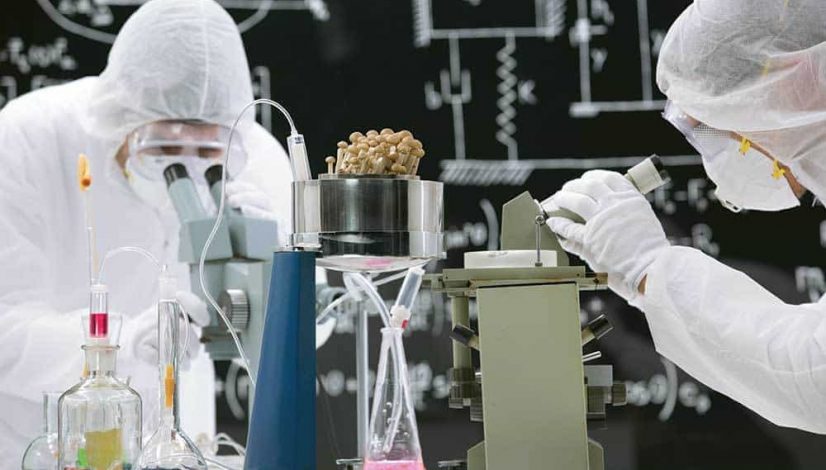Transformational Tripping
The post Transformational Tripping appeared first on High Times.
“Life lived in the absence of the psychedelic experience that primordial shamanism is based on is life trivialized, life denied, life enslaved to the ego.”
―Terence McKenna
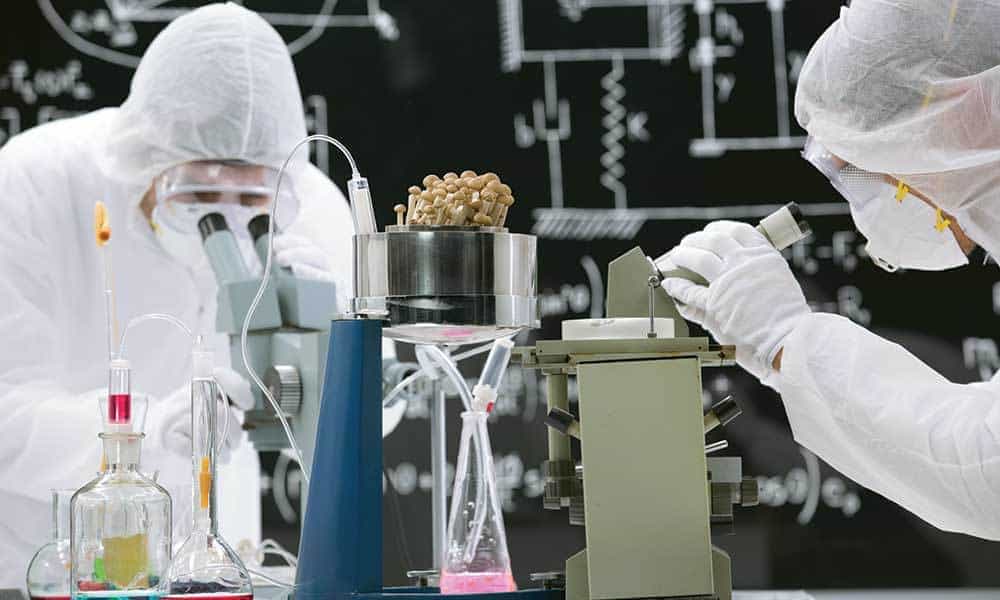
Research shows that psilocybin and other psychedelic compounds can treat depression, addiction, anxiety and more.
Earlier this year, author Ayelet Waldman’s A Really Good Day hit bookstores across America (HT Aug. ’17). Waldman’s remarkable memoir of her experiences microdosing with LSD was well-received, but it didn’t cause a perceptible stir. Seemingly, the story of a well-to-do, highly educated professional and middle-aged mom choosing to treat her persistent mood disorders with lysergic acid diethylamide wasn’t shocking enough to attract the attention of the pearl-clutchers who are normally all atwitter about how shameful and dangerous drug use is.
Far from the hysterical message of those “This Is Your Brain On Drugs” after-school PSAs of the 1980s, many of today’s news stories report on treating depression with psilocybin, the microdosing trend taking over Silicon Valley, and the push to hold clinical trials for MDMA as a treatment for post-traumatic stress disorder. The online journal Scientific Reports recently published findings that a single dose of ayahuasca rapidly reduced the symptoms of depression in treatment-resistant patients. Researchers also discovered compounds in the psychedelic Amazonian brew that actually stimulate the birth of new neurons—new brain cells. No wonder Ariel Levy, writing in the New Yorker, dubbed ayahuasca “the drug of choice for the age of kale.”
We live in an era “characterized by wellness cravings, when many Americans are eager for things like mindfulness, detoxification, and organic produce, and we are willing to suffer for our soulfulness,” Levy wrote. New Age lifestyle choices like hot yoga, jade eggs, and a never-ending parade of detoxes and cleanses espoused by slender celebrities like Gwyneth Paltrow are all the rage. No more Atkins Diet beach bodies and The Secret–style affirmations—we want enlightenment, not self-help, and we want it now.
Who can blame us? The constant news cycle of never-ending disasters both at home and abroad is intolerable. Social media have sucked the soul from a generation suffering from “tech neck”—a hunch (and wrinkles) developed from constantly looking down at a smartphone. Desperate for a reset button, people are seeking out greater meaning and healing through ancient plant-medicine wisdom. Others just want to enjoy life to the fullest through a change in perspective—read about the Amsterdam chefs cooking with psychedelic ingredients on page 62.
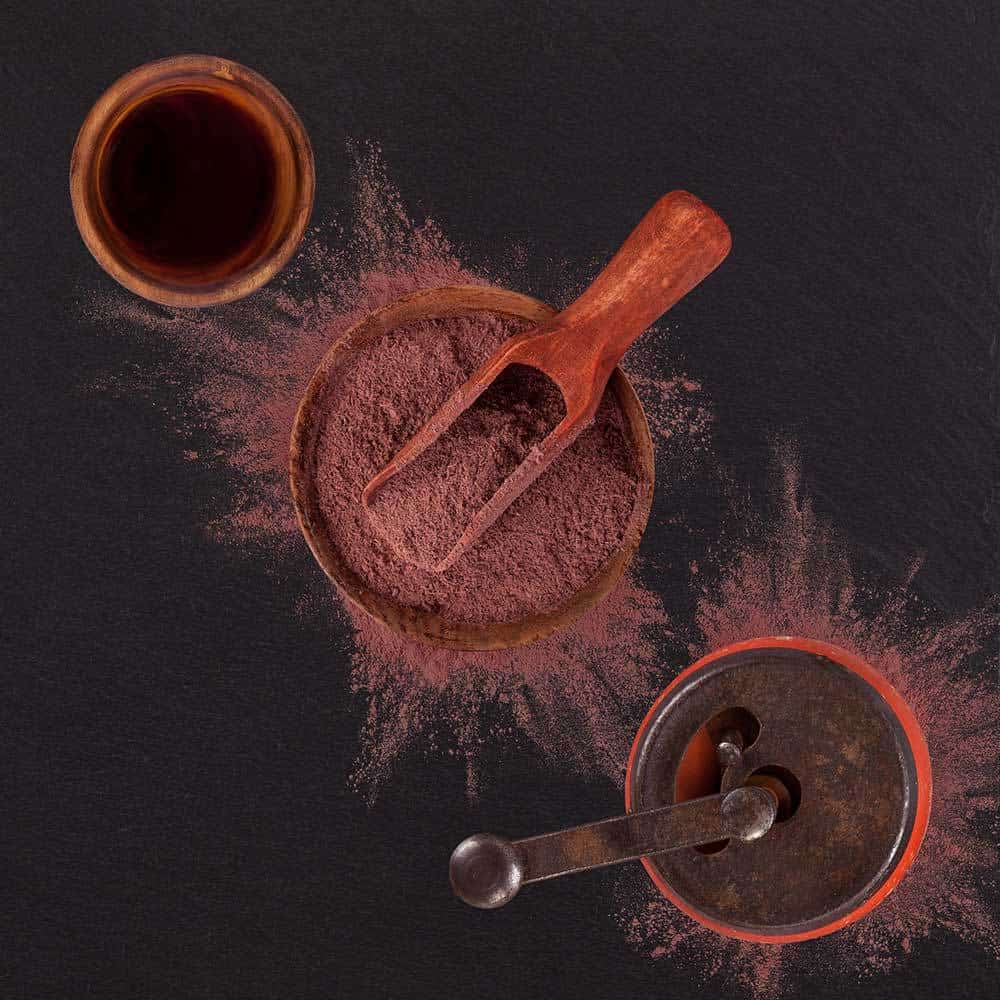
For centuries, shamans have used powerful psychedelic plant compounds to gain access to the spirit world.
Those in search of a path to enlightenment should avoid self-styled neo-shamans in hipster lofts and seek out a practiced guide to assist in what can often be a difficult undertaking. Veteran journalist Mark Franchetti has worked as a foreign correspondent in war zones; writing for the Times of London, he deemed his experiment with ayahuasca “by far the hardest thing I have experienced.” However, Franchetti added, “It was also the most profound.”
Ayahuasca, LSD and MDMA have received the lion’s share of media attention, but the list of therapeutic psychedelics is long. Most of them have been classified by the US government as Schedule I, meaning they’re designated as having no accepted medical use and a high potential for abuse. This includes ibogaine, a potent African entheogen with a long history of medicinal and ceremonial use, which has been proven to help treat opioid addiction. An exception to the Schedule I list is ketamine, which was developed as an anesthetic and mostly used as an animal tranquilizer. Ketamine has shown positive results in treating depression and PTSD; it is currently classified as Schedule III.
In Seattle, psychedelic guide Sebastian DeRosia avoids the draconian drug laws entirely with a process that uses kambo, the venom from the giant monkey frog (Phyllomedusa bicolor) native to the northwest Amazon rainforest. Kambo is legal throughout the world and is used to treat chronic pain, depression, headaches and more. DeRosia offers a kambo cleansing treatment at his cannabis-friendly bed-and-breakfast, the Winston House, where he provides guests with a “consciousness-expanding space.” People have started to seek out alternative therapies, DeRosia says, “because they no longer trust the medical establishment.”
If you’re looking for a specialist to help you with psychedelic-assisted therapy, start with the resources provided by the nonprofit Multidisciplinary Association for Psychedelic Studies. Since 1986, MAPS has been researching and educating people on the “medical, legal, and cultural contexts for people to benefit from the careful uses of psychedelics and marijuana.” The organization has been instrumental in the fight to help medical researchers obtain legal access to MDMA. MAPS also operates the Zendo Project, which employs a network of volunteers trained in psychedelic harm reduction to assist people at music festivals and other events.
Natalie Ginsberg, policy and advocacy director for MAPS, says that she hears stories every day of people taking psychedelics outside of clinical research, and finding healing on their own from PTSD and other conditions: “Though our research is intended to maximize the safety and beneficial outcomes of psychedelic use, we really recognize that people use psychedelics in many other contexts—they have used it in other cultures for thousands of years, and experience great benefits.”
For those taking psychedelics outside a medical context, Ginsberg warns that illegally procured substances can have a high risk of being adulterated. “The MDMA we are using in [MAPS’] research is often different than what’s found on the street. We are a proponent of reducing harms as much as possible. That involves testing the drugs, and making sure you’re taking the substances in a safe context, where you feel safe, both physically and psychologically.”
That’s also why the Zendo Project is in place at many events for festival-goers who have taken psychedelics and are having a difficult experience, says Ginsberg: “It’s there to help them through that difficult experience, and make it a more meaningful one.”
You can apply to volunteer for the Zendo Project, and learn more about how to help expand psychedelic peer counseling services and transform challenging psychedelic experiences into valuable learning opportunities at zendoproject.org.
Many of us are in search of that sense of “Be Here Now” that psychedelics can provide. At the end of her microdosing memoir, Ayelet Waldman recounts being surrounded by her husband and four children, all of them laughing while playing in the rain. She writes, “That day when I got out of my own head, stepped into the circle, and embraced the moment, in the rain—that was a really good day.”
For more information on the Multidisciplinary Association for Psychedelic Studies, visit maps.org.
An Elevated Feast
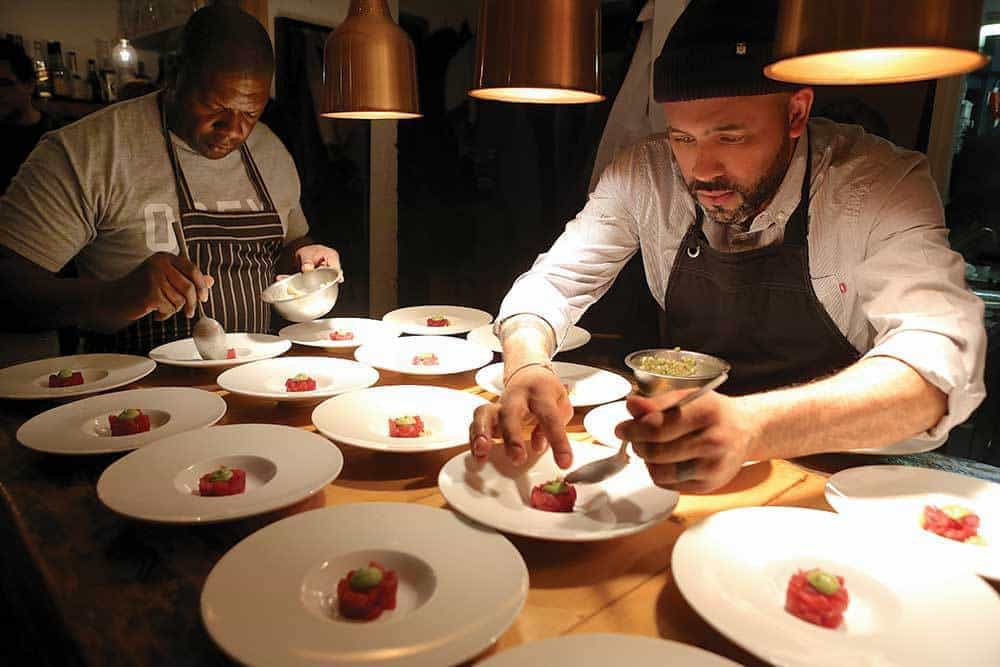
Anthony Joseph and Noah Tucker use psychoactive ingredients in their haute cuisine.
Entheogen-infused cuisine takes fine dining to new heights.
By Dara Colwell
Peculiar pairings often work. Think of a peanut-butter, bacon and banana sandwich. Or melon and prosciutto. And, especially since the legalization of marijuana in eight US states, just about anything—mac-and-cheese, beef jerky, Philly cheesesteak—with weed. In the case of Michelin-star chefs Noah Tucker and Tony Joseph, it’s pork cheeks and Hollandia truffles (yes, ’shrooms) in barbecue sauce.
Tucker and Joseph—from the US and the UK, respectively—now live in Amsterdam, where psychedelics like magic mushrooms are largely legal and readily available, making fine dining with Mary Jane alone passé. The duo has spent the last three years developing High Cuisine, a cookbook featuring the use of psychoactive ingredients like Syrian rue, kanna and magic-mushroom truffles, in addition to cannabis. They’ve also filmed a web series by the same name. The project is aimed at chefs, foodies and psychonauts inclined to pursue an upscale high from the comfort of their own kitchens.
Tucker and Joseph co-own Staring at Jacob, a restaurant in Amsterdam’s De Baarsjes neighborhood that offers American-style brunch and cocktails. The spot is a big hit with the Dutch. The cooking duo has the breezy familiarity of longtime friends who finish each other’s sentences, and yet they’re also an odd pairing. Tucker is talkative, outgoing, an avid weed smoker from New York who worked for Daniel Boulud. And then there’s Joseph: reserved, thoughtful, from East London; he worked for Éric Chavot and Marco Pierre White, and he loves a stiff drink.
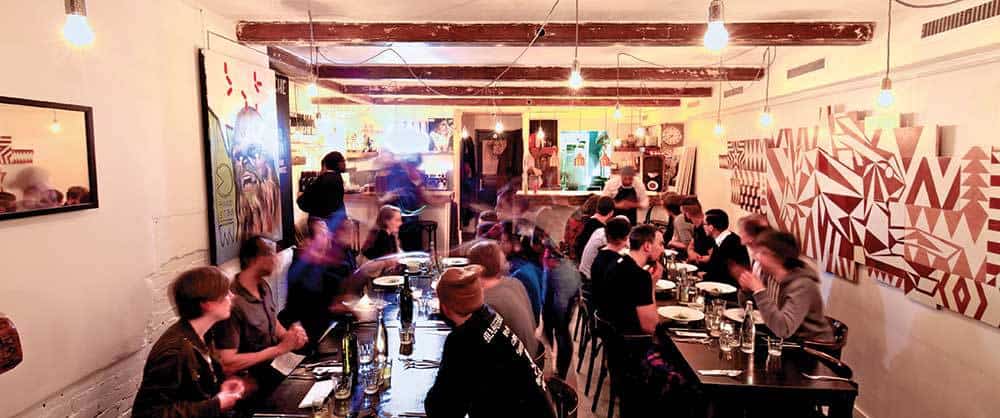
Diners enjoy the cozy ambience of Tucker and Joseph’s restaurant Staring at Jacob.
The duo met nine years ago in Amsterdam. While the city has a long history as a hub of global trade and enjoys a reputation for tolerance when it comes to soft drugs, it still lacks in the culinary department. So the two chefs opened a restaurant to help fill that gap—and then, in 2014, a five-star hotel commissioned them to create a high-end meal with weed for 25 guests.
Tucker, no stranger to psychedelics and to smoking and cooking with cannabis since his teens, believed they could take it up a notch. He wanted a challenge, and remembering his days of lacing White Castle burgers with ’shrooms, he didn’t have far to look. Since sclerotia are legal in the Netherlands, he decided to build the menu from there.
Joseph—who doesn’t do any drugs, period—was intrigued by the prospect of cooking with them. He explains, “Psychoactive ingredients? That was something I’d never seen before. I wanted to know how I could finesse them to make dishes palatable and accessible.”
After months of testing dishes on a small group of friends, the chefs created an eight-course psychoactive meal using Syrian rue, magic mushrooms, kanna, and various combinations of THC and CBD. Tucker says that learning how to microdose diners over multiple courses while achieving a consistent dosage and gourmet taste took plenty of practice, since every bite potentially involved a change in brain chemistry. “The irony is, you’re trying to control something that isn’t actually controllable,” he says.
The dinners generated increasing interest, so the chefs decided to offer their recipes in a cookbook to reach a wider audience where it counts—in the privacy of one’s own home, where psychedelics are most comfortably consumed.
“Most people cook a few times a week at home, so why not cook and dose yourself? That’s the beauty of it,” says Tucker, who sees psychedelic cuisine as a lifestyle choice that is gaining increasing acceptance.
Their Web series is a documentary-style travel-and-cooking show aimed at raising awareness about psychoactive plants by visiting the countries where they grow, like Brazil, Mexico and Indonesia. High Cuisine hopes to highlight the destructive practice of overharvesting, which is the case with peyote and ayahuasca (in some San Francisco circles, using ayahuasca is now akin to having a cup of coffee). That’s one reason High Cuisine’s recipes feature Syrian rue, which contains the same chemical compounds as the ayahuasca vine, yet costs only a few cents from online suppliers.
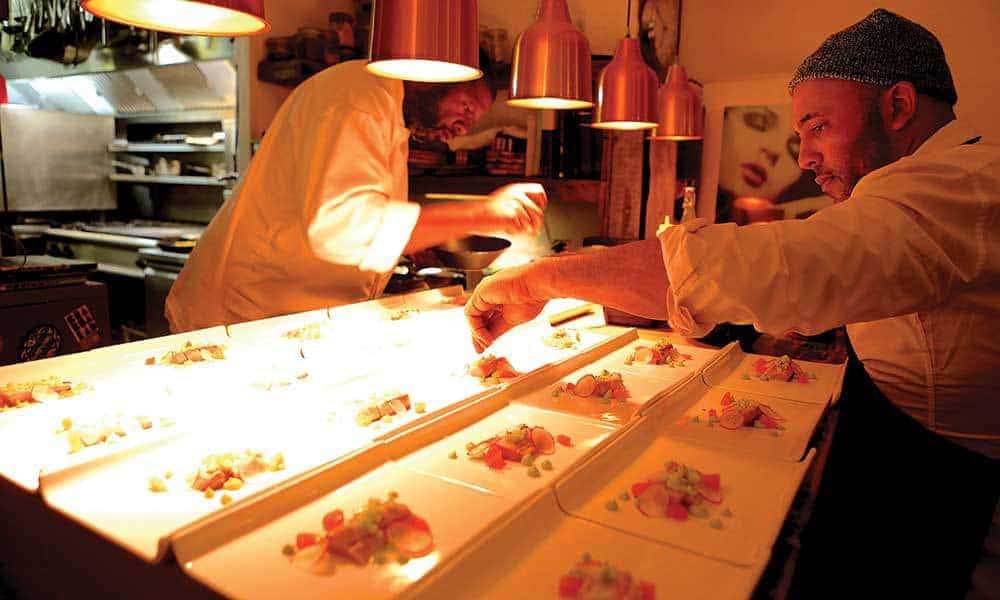
Putting the finishing touches on a feast for both body and mind.
With High Cuisine, Tucker and Joseph are seeking to get people intelligently high while furthering the conversation about why and how people choose to do it. “We’re prone to using substances, whether it’s coffee, nicotine, downing an espresso, smoking a joint or even stuffing our faces full of food,” Tucker notes. “It’s like our brain is on protest against controlled environments.” He explains that the psychoactive compounds featured in the cookbook have been around for thousands of years and are valued for their medicinal use. “They’re organic, natural, not government-controlled and actually good for you,” he says. And they also satisfy the very human need to expand our consciousness.
The post Transformational Tripping appeared first on High Times.

